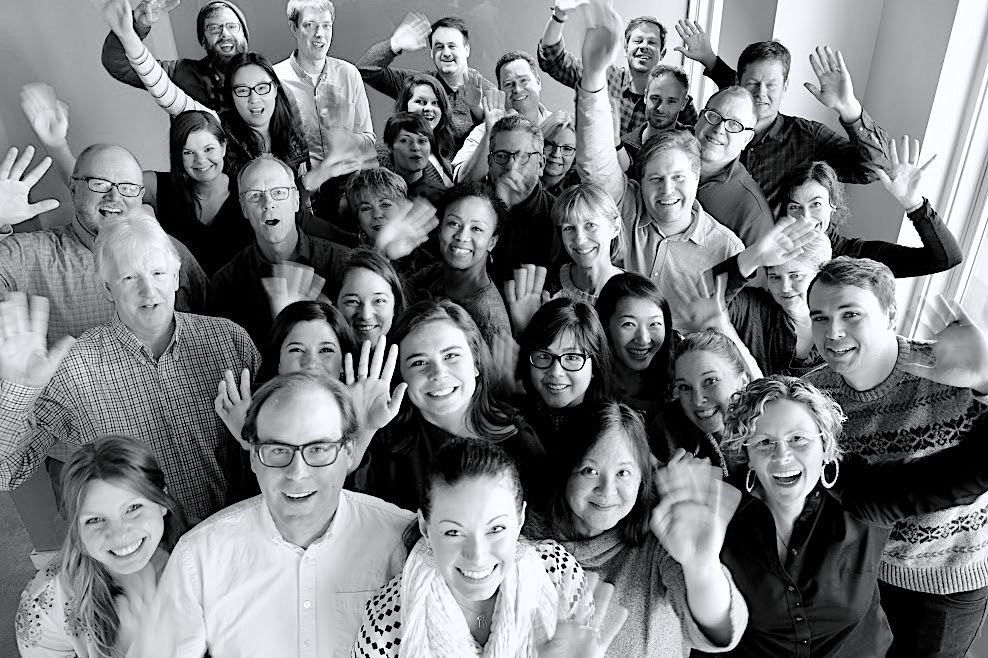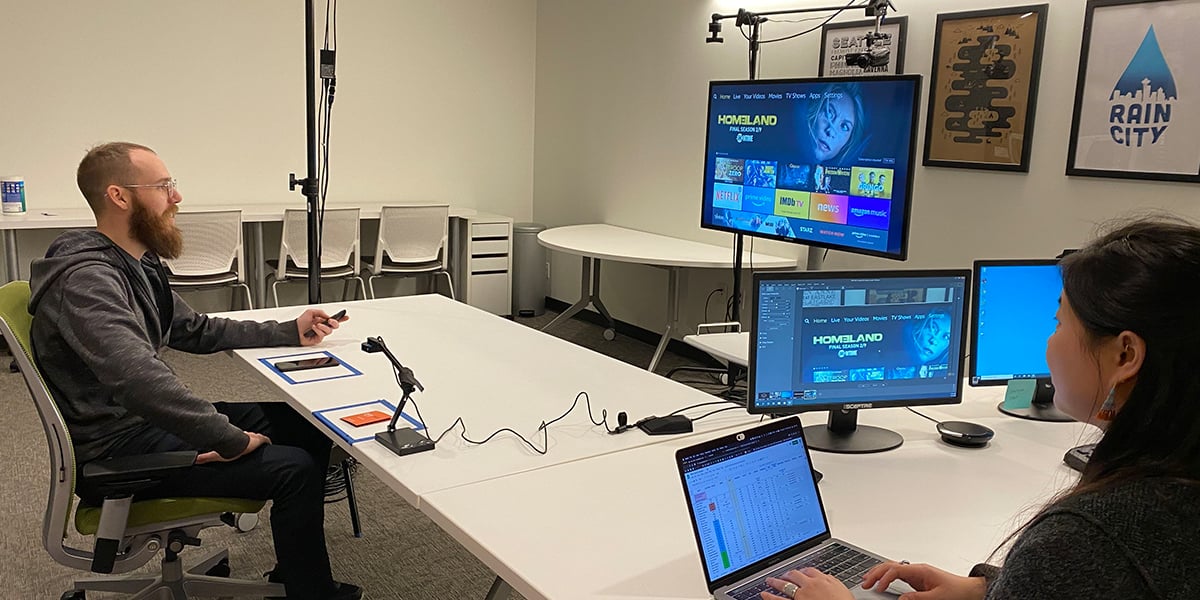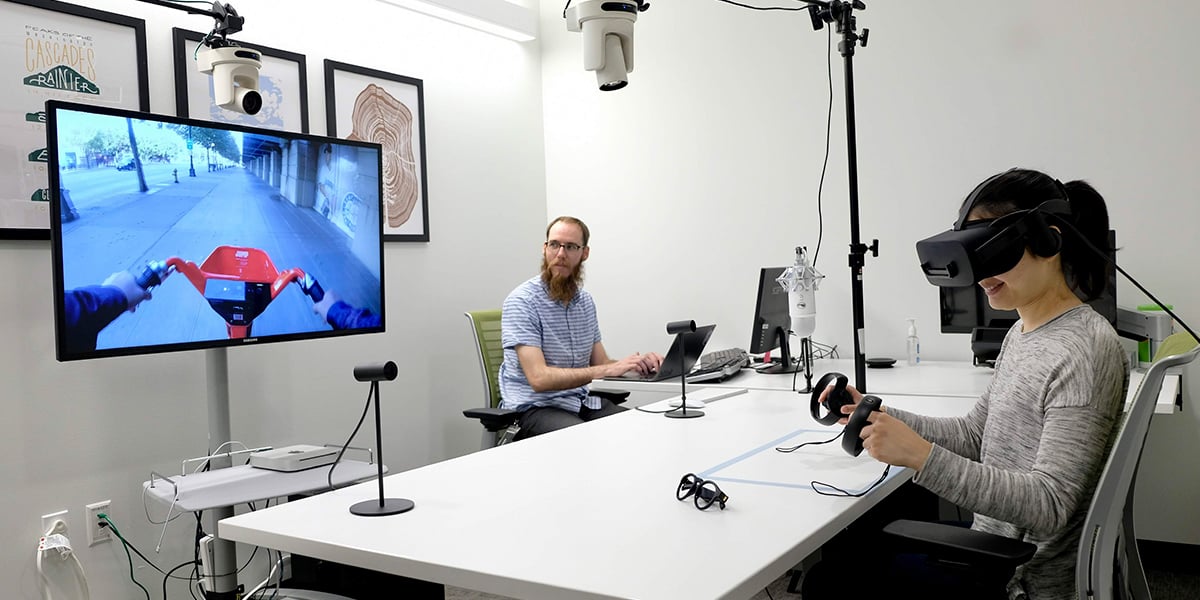
What is user research?
User research involves talking to and observing potential product users learn more about their motivations, behaviors, and needs. For example, in VR, user research could involve giving potential customers a VR headset and watching them interact with a corresponding software program to gather information about their experience.
Some standard research methods for VR products include:
- Diary studies: In a diary study, participants keep a journal of their experiences with your product, including any notable events, activities, emotions, or problems they encounter. This method is helpful for monitoring user experience over more extended periods.
- Usability testing: In a typical usability test, a moderator observes how participants interact with your product to complete a set of tasks. These studies can occur in a controlled lab environment or in the field if your product is intended for a specific context.
- Accessibility reviews: Conducting accessibility reviews allows you to discover how you can better accommodate the experiences of individuals with disabilities in various contexts.
Among other things, these tests could reveal important information such as:
- Whether controls are intuitive
- Whether experiences are immersive and fun
- What program factors might cause disorientation and sickness
User research helps optimize the VR software development process by uncovering what works well for users and doesn't. In addition, results from user research can inform VR interface design by finding opportunities to make the interface easier to use and more satisfying.
That's why it's so important to conduct user research early in the design process — if you wait to put even a basic prototype in front of your users, you might waste valuable time and money on a design that misses the mark.
Check our services page for more details about usability testing and other forms of user research.
Why is user research critical for VR?
Virtual reality is a new medium for potential customers and software developers. VR presents exciting possibilities for new interaction designs, yet numerous challenges currently await designers because of the immaturity of VR software design.
The well-established interaction patterns and conventions of more mature design landscapes, such as desktop or mobile computing, allow designers to create programs that match what users have come to expect. For example, desktop users have become accustomed to clicking a button in the corner of a window to close a program. Similarly, smartphone users are familiar with mechanics such as the hamburger menu and pinch-to-zoom.
VR, on the other hand, is a whole new world for designers. Since 3D VR environments often afford substantially different modes of interaction than other software interfaces, touch screen, and desktop software conventions sometimes do not directly map to VR interactions. Additionally, the experiences people find entertaining and compelling on a flat screen may differ significantly from those they enjoy in a 3D software environment.
As a result, many VR interactions are experiments that require user validation — user research is critical for the success of new VR software.

How is user research different for VR than for other types of software?
At its basic level, user research is about understanding users, not software. This means VR user research is similar to user research for other types of software development.
The same usability testing techniques that work well for traditional software, such as giving users tasks, asking users to think aloud, and observing their behavior, work just as well when testing users in a virtual environment. As with other forms of software testing, VR testing enables you to observe and capture what the user sees and how they react to it.
However, VR software testing requires you to consider some factors that are unique to VR, such as:
- Participant motion and direction: VR users may move their heads and limbs in different directions and walk around a small space. Designers must validate that their software designs are not forcing users into uncomfortable or potentially dangerous body positions and movements.
- Interaction between physical and virtual worlds: Many VR programs require users to move through their physical space to interact with virtual objects and environments, often resulting in a disconnect between physical and virtual. Handled poorly, this difference can negatively impact the feeling of being present in a virtual environment, which is a crucial consideration for VR programs using this mechanic.
- Physiological response: The disconnect between the real world and the virtual environment can cause some individuals to experience balance issues and motion sickness, also known as VR sickness or cyber sickness. Virtual reality testing can reveal what elements of a VR program trigger uncomfortable physiological responses so you can address them early.
- Hardware comfort: VR programs involve many different pieces of equipment that may cause user discomforts, such as headsets, wires, and unfamiliar controllers. Researchers need to assess each device's comfort level for both short- and long-term use to ensure an enjoyable user experience.
How is Blink equipped for virtual reality research?
With more than 20 years of experience in UX design and research, we've had plenty of time to gather the resources and expertise to conduct thorough VR testing so you can better understand your users. In addition, many of our team members have graduate degrees in fields beneficial for VR user research, such as Cognitive Psychology and Human Centered Design and Engineering.
Additionally, our Seattle studio has six testing labs equipped with the following:
- Space: All three labs offer abundant space for seated VR experiences, and our more extensive labs are suitable for VR experiences involving more motion.
- Cameras: Each lab contains multiple cameras to record behavior from several angles, including the participant's hand interactions and facial expressions.
- Screen: Each lab also contains a screen so the research moderator can observe the user's experiences in the virtual environment.
Our research moderators collect participant feedback in one of two ways — by verbally asking questions or overlaying surveys in the virtual environment. The second approach works exceptionally well for diary studies in which users interact with VR software in their homes.
We record research sessions and stream them from Blink's Feedback Panel research tool. After user sessions, researchers can use timestamps with telemetry information to link headset positioning to participant behavior and software events, providing key insights into the user experience. These recordings are available for client download shortly after each research session ends.

Blink can help you tackle VR user testing
Understanding your users is essential for ensuring a satisfying virtual reality user experience and market success. Unsure what research approach to take? Contact us today for more information.
